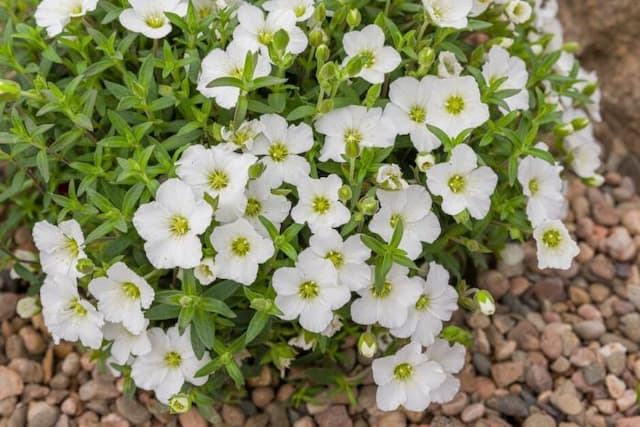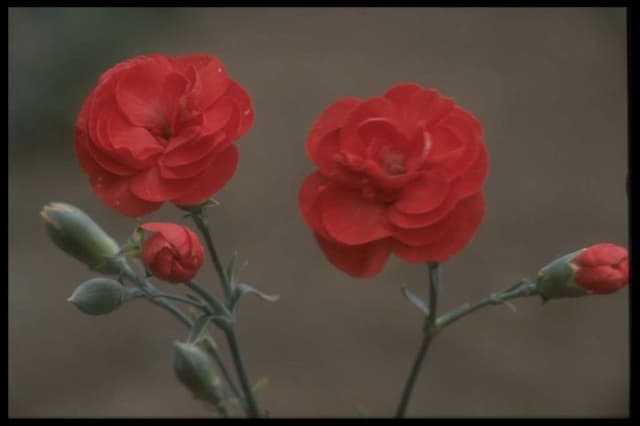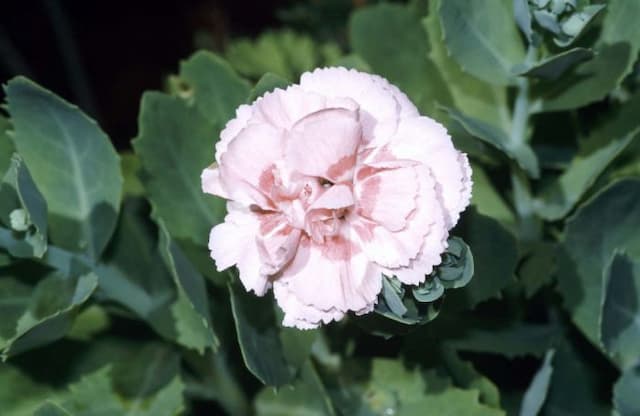Cheddar Pink Dianthus 'Devon Judith' (PBR) (p)

ABOUT
Dianthus 'Devon Judith', commonly known as Sweet William, presents a delightful spectacle with its vibrant and colorful flowers. The blossoms are a charming mix of shades, often displaying a striking bicolor pattern with a contrasting eye at the center of each flower. These eye-catching blooms form dense clusters atop slender, sturdy stems, adding to the plant's ornamental appeal. The foliage of the Sweet William is also notable. The leaves are typically slender, with a blue-green hue that provides a beautiful contrast to the vivid flowers. The plant's overall structure is neat and compact, giving it a tidy appearance that makes it a favorite among gardeners who seek to create aesthetically pleasing garden spaces. Throughout its blooming season, Sweet William exudes a sweet, clove-like fragrance that is particularly strong in the early morning and evening. This scent is a magnet for pollinators, such as bees and butterflies, adding to the plant's charm and its ecological value in the garden. All in all, the Dianthus 'Devon Judith' is celebrated for its picturesque blooms, delightful fragrance, and attractive foliage, making it an excellent choice for borders, beds, and containers where a splash of color and a pleasant aroma are desired.
About this plant
 Names
NamesFamily
Caryophyllaceae
Synonyms
Devon Cottage Pinball Wizard, Cheddar Pink, Cottage Pink
Common names
Dianthus 'Devon Judith' (PBR) (p)
 Toxicity
ToxicityTo humans
The Dianthus 'Devon Judith', commonly known as Pink, is generally considered non-toxic to humans. Therefore, accidental ingestion of this plant typically does not cause serious harm or symptoms of poisoning. However, it is always advisable to avoid eating ornamental plants as they are not intended for consumption.
To pets
Pinks, including the variety Dianthus 'Devon Judith', are generally recognized as safe for pets and are not known to be toxic. If a pet ingests part of this plant, it is unlikely to cause poisoning or serious health issues. As with humans, it is still best to prevent pets from consuming ornamental plants as a precaution.
 Characteristics
CharacteristicsLife cycle
Perennials
Foliage type
Evergreen
Color of leaves
Blue-green
Flower color
Pink
Height
0 feet 10 inches (25 cm)
Spread
0 feet 12 inches (30 cm)
Plant type
Herb
Hardiness zones
7
Native area
Europe
Benefits
 General Benefits
General Benefits- Attractive Flowers: Dianthus 'Devon Judith' produces vibrant and colorful blossoms that enhance the aesthetic appeal of gardens and landscapes.
- Pleasant Fragrance: The plant is known for its sweet and spicy scent which adds a sensory dimension to garden spaces.
- Long Blooming Season: It typically has a long flowering period, providing visual interest throughout the growing season.
- Drought Tolerance: Once established, this variety of Dianthus can tolerate periods of dry weather, making it suitable for xeriscaping.
- Low Maintenance: It requires minimal care, making it ideal for gardeners looking for low-maintenance plants.
- Cold Hardy: This plant is capable of withstanding cooler temperatures, making it suitable for a range of climates.
- Attracts Pollinators: The flowers attract bees, butterflies, and other beneficial pollinators, supporting biodiversity.
- Versatility: It can be used in rock gardens, borders, containers, or as ground cover, offering great versatility in landscaping.
- Deer Resistance: The foliage and flowers are less palatable to deer, reducing the likelihood of damage from grazing.
 Medical Properties
Medical PropertiesThis plant is not used for medical purposes.
 Air-purifying Qualities
Air-purifying QualitiesThis plant is not specifically known for air purifying qualities.
 Other Uses
Other Uses- Carnation crafts: The flowers of the Carnation can be dried and used in potpourri or sachets to provide a lasting fragrance to drawers and closets.
- Edible decoration: Carnation petals are edible and can be used to decorate cakes, salads, or cocktails, adding a splash of color and a hint of spice.
- Natural dye: The bright and rich colors of Carnation petals can be used to create natural dyes for fabrics or papers.
- Floral water: Petals can be steeped in water to make a lightly scented floral water that can be used as a refreshing face toner or room spray.
- Culinary uses: The flowers can be crystallized with sugar and used as an elegant garnish for desserts.
- Bookmarks: Pressed Carnation flowers can be laminated or placed within the pages of a book to create delicate and fragrant bookmarks.
- Scented candles: Infuse wax with Carnation petals to make scented candles, adding a soft floral aroma to any room.
- Flower confetti: Dried Carnation petals can be tossed as biodegradable confetti at weddings or other celebrations.
- Artistic inspiration: The rich colors and patterns of Carnation petals can be used by artists as subject matter for paintings, drawings, or textile designs.
- Greeting cards: Pressed or dried Carnation flowers can be adhered to the front of handmade greeting cards for a personal touch.
Interesting Facts
 Feng Shui
Feng ShuiThe Pink is not used in Feng Shui practice.
 Zodiac Sign Compitability
Zodiac Sign CompitabilityThe Pink is not used in astrology practice.
 Plant Symbolism
Plant Symbolism- Love: As a member of the carnation family, Dianthus 'Devon Judith' often symbolizes love and affection. The petals and the vibrant coloration represent a heartfelt emotion.
- Admiration: The bright appearance and enduring nature of Dianthus can signify admiration, conveying respect and high esteem for someone.
- Pure Affection: The purity of the flower's white petals, if present, can symbolize pure love or affection, signifying honest and sincere emotion.
- Distinction: Dianthus is known for its unique and spicy fragrance, which can represent individuality or an innate desire to stand out.
- Divine Love: In some historical contexts, Dianthus flowers have been associated with the divine, conveying a message of spiritual or celestial love.
 Water
WaterPink Dianthus, commonly known as Pink Kisses, should be watered thoroughly when the top inch of the soil feels dry to the touch. It typically needs water once or twice a week, depending on the weather conditions and soil drainage. It's best to water the plant in the early morning or late afternoon, allowing the foliage to dry before the temperature drops at night. During very hot spells, the plant may require more frequent watering, but be careful not to overwater as this can lead to root rot. When watering, apply approximately 1 gallon of water for each plant, ensuring you wet the root zone rather than just the surface.
 Light
LightPink Dianthus thrives in full sun conditions, meaning it prefers to receive at least 6 to 8 hours of direct sunlight daily. The best spot for this plant is an area that provides unfiltered sunlight for most of the day. If you live in an extremely hot climate, some light afternoon shade can help prevent scorching.
 Temperature
TemperaturePink Dianthus performs well in moderate to cool climates and can survive temperatures as low as 20°F and as high as 85°F. However, the ideal temperature range for this plant is between 60°F and 70°F. These plants are reasonably hardy, but prolonged exposure to temperatures outside their comfort range may inhibit growth and flowering.
 Pruning
PruningPink Dianthus benefits from pruning to encourage bushier growth and more flowers. Deadheading, or removing spent flower heads, should be done regularly to promote continuous blooming throughout the season. The best time for a more substantial prune, cutting back the foliage, is in early spring or after the first flush of flowers in the summer to rejuvenate the plant's growth.
 Cleaning
CleaningAs needed
 Soil
SoilThe best soil mix for the Sweet William is well-draining, loamy, and slightly alkaline with a pH of around 7.0 to 7.5. A mix composed of equal parts garden soil, compost, and sharp sand or perlite ensures good drainage and fertility.
 Repotting
RepottingSweet William typically does not require frequent repotting and can thrive in the same container for multiple years. They should only be repotted if they outgrow their current pot or if the soil quality deteriorates markedly.
 Humidity & Misting
Humidity & MistingSweet William prefers moderate humidity conditions and does not require high humidity levels. Average room humidity is typically sufficient for growing Sweet William indoors.
 Suitable locations
Suitable locationsIndoor
Place Sweet William near a sunny window in well-draining soil.
Outdoor
Plant Sweet William in full sun to part shade in fertile soil.
Hardiness zone
3-9 USDA
 Life cycle
Life cycleDianthus 'Devon Judith', commonly known as Cheddar Pink, starts its life as a seed, which upon germination, develops into a seedling with its first set of true leaves. As the plant grows, it forms a tight cluster of foliage at the base, entering the vegetative stage where energy is directed towards leaf and stem growth. Upon reaching maturity, it enters the flowering stage, typically in late spring to early summer, producing fragrant pinkish-purple flowers with a distinctive frilled edge. After pollination, often by bees or butterflies, the flowers develop into seed capsules containing numerous small seeds. The plant then enters a period of dormancy, especially in colder climates, where it may die back during the winter months before regrowing from the base the following spring. With proper care, Dianthus 'Devon Judith' is a perennial, capable of living several years, repeating its growth and reproductive cycle annually.
 Propogation
PropogationPropogation time
Spring to Summer
Dianthus 'Devon Judith', commonly known as Pink, is often propagated through the division method, which is considered the most popular for this perennial plant. The optimum time to carry out division is typically in the spring or early fall when the weather is cool, allowing the roots to establish without the stress of midsummer heat. To propagate by division, the gardener should carefully dig up an established clump of Pinks, ensuring to get as much of the root system as possible. The clump is then gently separated into smaller sections, each with a good amount of roots and several shoots. These sections are replanted at the same depth they were growing previously, spaced about 12 inches (approximately 30 cm) apart to give each new plant enough space to grow. Plants should be watered thoroughly after planting to help settle the soil around the roots. With proper care, these divisions will grow into healthy, blooming plants in the following season.



![Pink [Tequila Sunrise]](/_next/image?url=https%3A%2F%2Fplants-admin.emdemapps.com%2Fimages%2Fplants%2F%2Fimages%2F604b5d995d06e.png&w=640&q=75)





